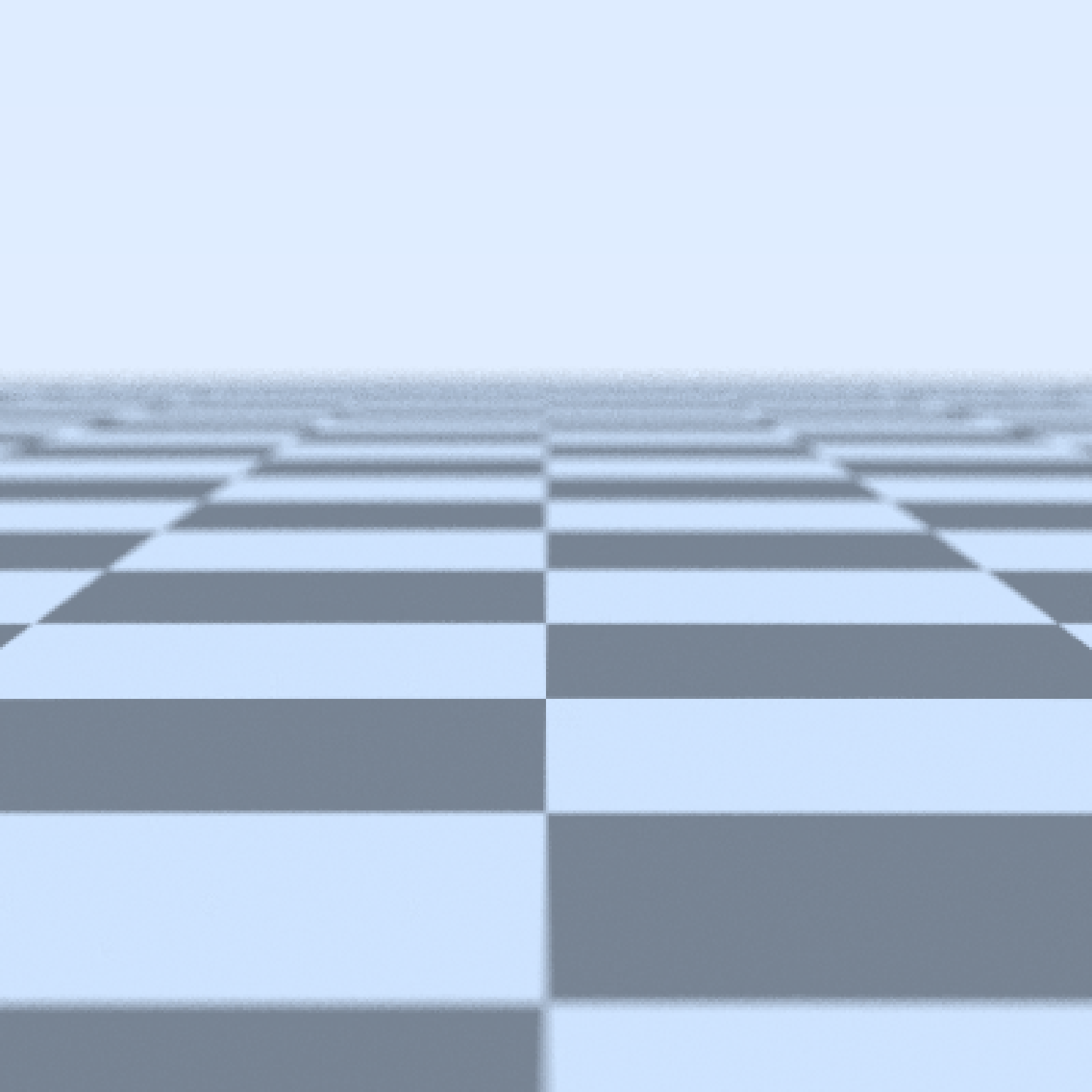Dielectric (glass) Material
dielectric(
color = "white",
refraction = 1.5,
attenuation = c(0, 0, 0),
attenuation_intensity = 1,
priority = 0,
importance_sample = FALSE,
bump_texture = "",
bump_intensity = 1
)Arguments
- color
Default `white`. The color of the surface. Can be either a hexadecimal code, R color string, or a numeric rgb vector listing three intensities between `0` and `1`.
- refraction
Default `1.5`. The index of refraction.
- attenuation
Default `c(0,0,0)`. The Beer-Lambert color-channel specific exponential attenuation through the material. Higher numbers will result in less of that color making it through the material. If a character string is provided (either as a named R color or a hex string), this will be converted to a length-3 vector equal to one minus the RGB color vector, which should approximate the color being passed. Note: This assumes the object has a closed surface.
- attenuation_intensity
Default `1`. Changes the attenuation by a multiplicative factor. Values lower than one will make the dielectric more transparent, while values greater than one will make the glass more opaque.
- priority
Default `0`. When two dielectric materials overlap, the one with the lower priority value is used for intersection. NOTE: If the camera is placed inside a dielectric object, its priority value will not be taken into account when determining hits to other objects also inside the object.
- importance_sample
Default `FALSE`. If `TRUE`, the object will be sampled explicitly during the rendering process. If the object is particularly important in contributing to the light paths in the image (e.g. light sources, refracting glass ball with caustics, metal objects concentrating light), this will help with the convergence of the image.
- bump_texture
Default `""`. A matrix, array, or filename (specifying a greyscale image) to be used to specify a bump map for the surface.
- bump_intensity
Default `1`. Intensity of the bump map. High values may lead to unphysical results.
Value
Single row of a tibble describing the dielectric material.
Examples
#Generate a checkered ground
scene = generate_ground(depth=-0.5, material = diffuse(checkercolor="grey30",checkerperiod=2))
if(run_documentation()) {
render_scene(scene,parallel=TRUE, samples=16)
}
 #Add a glass sphere
if(run_documentation()) {
scene %>%
add_object(sphere(x=-0.5,radius=0.5,material=dielectric())) %>%
render_scene(parallel=TRUE,samples=16)
}
#Add a glass sphere
if(run_documentation()) {
scene %>%
add_object(sphere(x=-0.5,radius=0.5,material=dielectric())) %>%
render_scene(parallel=TRUE,samples=16)
}
 #Add a rotated colored glass cube
if(run_documentation()) {
scene %>%
add_object(sphere(x=-0.5,radius=0.5,material=dielectric())) %>%
add_object(cube(x=0.5,xwidth=0.5,material=dielectric(color="darkgreen"),angle=c(0,-45,0))) %>%
render_scene(parallel=TRUE,samples=16)
}
#Add a rotated colored glass cube
if(run_documentation()) {
scene %>%
add_object(sphere(x=-0.5,radius=0.5,material=dielectric())) %>%
add_object(cube(x=0.5,xwidth=0.5,material=dielectric(color="darkgreen"),angle=c(0,-45,0))) %>%
render_scene(parallel=TRUE,samples=16)
}
 #Add an area light behind and at an angle and turn off the ambient lighting
if(run_documentation()) {
scene %>%
add_object(sphere(x=-0.5,radius=0.5,material=dielectric())) %>%
add_object(cube(x=0.5,xwidth=0.5,material=dielectric(color="darkgreen"),angle=c(0,-45,0))) %>%
add_object(yz_rect(z=-3,y=1,x=0,zwidth=3,ywidth=1.5,
material=light(intensity=15),
angle=c(0,-90,45), order_rotation = c(3,2,1))) %>%
render_scene(parallel=TRUE,aperture=0, ambient_light=FALSE,samples=16)
}
#Add an area light behind and at an angle and turn off the ambient lighting
if(run_documentation()) {
scene %>%
add_object(sphere(x=-0.5,radius=0.5,material=dielectric())) %>%
add_object(cube(x=0.5,xwidth=0.5,material=dielectric(color="darkgreen"),angle=c(0,-45,0))) %>%
add_object(yz_rect(z=-3,y=1,x=0,zwidth=3,ywidth=1.5,
material=light(intensity=15),
angle=c(0,-90,45), order_rotation = c(3,2,1))) %>%
render_scene(parallel=TRUE,aperture=0, ambient_light=FALSE,samples=16)
}
 #Color glass using Beer-Lambert attenuation, which attenuates light on a per-channel
#basis as it travels through the material. This effect is what gives some types of glass
#a green glow at the edges. We will get this effect by setting a lower attenuation value
#for the `green` (second) channel in the dielectric `attenuation` argument.
if(run_documentation()) {
generate_ground(depth=-0.5,material=diffuse(checkercolor="grey30",checkerperiod=2)) %>%
add_object(sphere(z=-5,x=-0.5,y=1,material=light(intensity=10))) %>%
add_object(cube(y=0.3,ywidth=0.1,xwidth=2,zwidth=2,
material=dielectric(attenuation=c(1.2,0.2,1.2)),angle=c(45,110,0))) %>%
render_scene(parallel=TRUE, samples = 16)
}
#Color glass using Beer-Lambert attenuation, which attenuates light on a per-channel
#basis as it travels through the material. This effect is what gives some types of glass
#a green glow at the edges. We will get this effect by setting a lower attenuation value
#for the `green` (second) channel in the dielectric `attenuation` argument.
if(run_documentation()) {
generate_ground(depth=-0.5,material=diffuse(checkercolor="grey30",checkerperiod=2)) %>%
add_object(sphere(z=-5,x=-0.5,y=1,material=light(intensity=10))) %>%
add_object(cube(y=0.3,ywidth=0.1,xwidth=2,zwidth=2,
material=dielectric(attenuation=c(1.2,0.2,1.2)),angle=c(45,110,0))) %>%
render_scene(parallel=TRUE, samples = 16)
}
 #If you have overlapping dielectrics, the `priority` value can help disambiguate what
#object wins. Here, I place a bubble inside a cube by setting a lower priority value and
#making the inner sphere have a index of refraction of 1. I also place spheres at the corners.
if(run_documentation()) {
generate_ground(depth=-0.51,material=diffuse(checkercolor="grey30",checkerperiod=2)) %>%
add_object(cube(material = dielectric(priority=2, attenuation = c(10,3,10)))) %>%
add_object(sphere(radius=0.49,material = dielectric(priority=1, refraction=1))) %>%
add_object(sphere(radius=0.25,x=0.5,z=-0.5,y=0.5,
material = dielectric(priority=0,attenuation = c(10,3,10) ))) %>%
add_object(sphere(radius=0.25,x=-0.5,z=0.5,y=0.5,
material = dielectric(priority=0,attenuation = c(10,3,10)))) %>%
render_scene(parallel=TRUE, samples = 16,lookfrom=c(5,1,5))
}
#If you have overlapping dielectrics, the `priority` value can help disambiguate what
#object wins. Here, I place a bubble inside a cube by setting a lower priority value and
#making the inner sphere have a index of refraction of 1. I also place spheres at the corners.
if(run_documentation()) {
generate_ground(depth=-0.51,material=diffuse(checkercolor="grey30",checkerperiod=2)) %>%
add_object(cube(material = dielectric(priority=2, attenuation = c(10,3,10)))) %>%
add_object(sphere(radius=0.49,material = dielectric(priority=1, refraction=1))) %>%
add_object(sphere(radius=0.25,x=0.5,z=-0.5,y=0.5,
material = dielectric(priority=0,attenuation = c(10,3,10) ))) %>%
add_object(sphere(radius=0.25,x=-0.5,z=0.5,y=0.5,
material = dielectric(priority=0,attenuation = c(10,3,10)))) %>%
render_scene(parallel=TRUE, samples = 16,lookfrom=c(5,1,5))
}
 # We can also use this as a basic Constructive Solid Geometry interface by setting
# the index of refraction equal to empty space, 1. This will subtract out those regions.
# Here I make a concave lens by subtracting two spheres from a cube.
if(run_documentation()) {
generate_ground(depth=-0.51,material=diffuse(checkercolor="grey30",checkerperiod=2,sigma=90)) %>%
add_object(cube(material = dielectric(attenuation = c(3,3,1),priority=1))) %>%
add_object(sphere(radius=1,x=1.01,
material = dielectric(priority=0,refraction=1))) %>%
add_object(sphere(radius=1,x=-1.01,
material = dielectric(priority=0,refraction=1))) %>%
add_object(sphere(y=10,x=3,material=light(intensit=150))) %>%
render_scene(parallel=TRUE, samples = 16,lookfrom=c(5,3,5))
}
# We can also use this as a basic Constructive Solid Geometry interface by setting
# the index of refraction equal to empty space, 1. This will subtract out those regions.
# Here I make a concave lens by subtracting two spheres from a cube.
if(run_documentation()) {
generate_ground(depth=-0.51,material=diffuse(checkercolor="grey30",checkerperiod=2,sigma=90)) %>%
add_object(cube(material = dielectric(attenuation = c(3,3,1),priority=1))) %>%
add_object(sphere(radius=1,x=1.01,
material = dielectric(priority=0,refraction=1))) %>%
add_object(sphere(radius=1,x=-1.01,
material = dielectric(priority=0,refraction=1))) %>%
add_object(sphere(y=10,x=3,material=light(intensit=150))) %>%
render_scene(parallel=TRUE, samples = 16,lookfrom=c(5,3,5))
}
